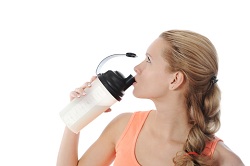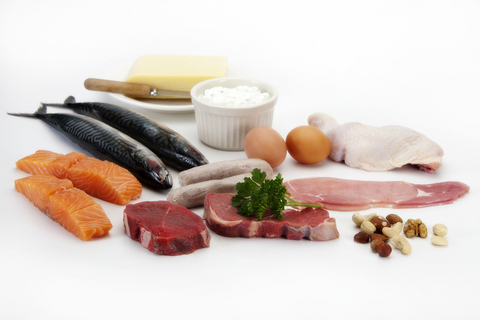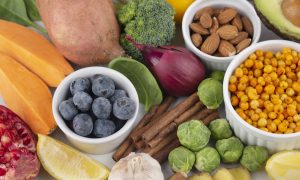How much, what kind, and when?
By Emily C. Harrison MS, RD, LD
Do dancers need extra protein? Do they need to use powders, drinks, shakes or amino acid supplements or should they just eat more? In the wake of the highly misguided “low carb” craze and in light of all the recent headlines about how eating too much meat and dairy can increase risk for long term diseases…what is a dancer to do? How much is enough, what kind of protein is best, and does timing matter?
How Much?
Yes, dancers need more protein than the average non-athletic person, particularly if they are still growing adolescents. However, it is important that we get away from this incorrect idea that most of our food should be protein and that we should avoid carbohydrates. Protein is important, but too much protein is actually harmful to the body. Everyone is a little different, but it is recommended for athletes that 12-15% of total calories should come from protein.
What does that mean exactly?
Everyone’s caloric needs vary, but if a dancer needs approximately 2000 calories a day, then they need about 60-75 grams of protein in their diet. (This is an average and not intended to be the amount for all).
Here are examples:
A 115 lb female dancer needs about 60-78 grams of protein each day.
A 170 lb male dancer needs about 90-108 grams
There’s a range because different dancers have different activity levels and therefore need more calories.
Real food examples of protein content:
| Typical fast food hamburger | 27 g protein, 600 calories, 40 g fat |
| 3 oz grilled chicken | 20 g protein, 111 calories, 3 g fat |
| 1 cup black beans and rice | 12 g protein, 222 calories, 1 g fat |
| Quinoa cakes pan fried in canola oil | 8 g protein, 300 calories, 12 g fat |
| 1 cup soy milk, chocolate flavored | 5 g protein, 141 calories, 3.5 g fat |
| 1 cup black eyed peas, walnut, and couscous salad | 10 g protein, 224 calories, 5.2 g fat |
What Kind?
Unless a dancer is dieting or restricting calories (which I generally don’t recommend), they can easily meet their protein needs through food alone. Supplemental protein is expensive and unnecessary. In general, people in the U.S., including athletes, get far more protein than they need. It is a myth that you need to load up on protein powders, drinks, or bars or that it should form the bulk of your food intake. Carbs are actually far more important fuel for working dancers. Protein drinks and bars can be convenient for busy dancers, but it is always better to get nutrients through real food. Research shows that the risk for long-term disease such as stroke, diabetes, heart disease, and cancer is significantly decreased when the majority of protein consumption comes from plant-based foods. Some examples are beans, peas, lentils, nuts, seeds, grains, and of course vegetables. Whey protein (isolated from cow’s milk) has been in the news lately as good for recovery. Some whey protein supplements, such as in a recovery beverage, might help dancers bounce back on a heavy show weekend, but there can always be too much of a good thing.
 When?
When?
The body is better able to utilize protein when it is eaten in moderate regular doses throughout the day and also post workout.
Try to divide up total daily dietary protein into regular meals and snacks. For example, a professional level dancer would need to eat a little protein (10-20 grams) every 2-3 hours during the work day. Aim for at least 6 small meals/ snacks per day.
Try to eat 10-20 grams of protein with a balanced meal within 1 hour post-exercise. However, some studies show that the body’s muscle building/repair response will still occur if the protein is eaten within 24 hours of exercise.
According to K. Tipton PhD “there is a limit to the amount of protein that will effectively increase the anabolic response”. Essentially, when an athlete eats up to approximately 20 grams of protein at one sitting then it may be used to build muscle, but there is no difference in muscle response when given 20-40 grams at a time. So it seems that protein loading doesn’t do any good. When total dietary protein is ingested in small, frequent amounts throughout the day then the body responds much better and can utilize it for what protein is meant for. Eating beyond the body’s capacity to use it, means it gets stored as fat or used as fuel. And the body doesn’t really like to use protein as a fuel source.
Excess protein…what’s the problem with eating too much?
When protein is used as fuel, particularly when there is not enough carb or fat in the diet, it is hard on the body and can actually do more harm than good. Here’s why:
- The body doesn’t like to use protein as fuel or energy. The body wants to spare valuable protein for muscle building, making hormones, enzymes, controlling fluid balance, etc.
- Excess protein means excess nitrogen, a part of protein (amino acids) that must be removed. This can be hard on the kidneys. More importantly water gets excreted in this process and can lead to dehydration.
- High protein diets can lead to more calcium being lost from the bones, a big problem for dancers who are at higher than average risk for stress fractures. Protein overload = weaker bones.
 Emily Cook Harrison MS, RD, LD
Emily Cook Harrison MS, RD, LD
Emily is a registered dietitian and holds both a bachelor’s and master’s degree in nutrition from Georgia State University. Her master’s thesis research was on elite level ballet dancers and nutrition and she has experience providing nutrition services for weight management, sports nutrition, disordered eating, disease prevention, and food allergies. Emily was a professional dancer for eleven years with the Atlanta Ballet and several other companies. She is a dance educator and the mother of two young children. She now runs the Centre for Dance Nutrition and Healthy Lifestyles. She can be reached at emily@dancernutrition.com www.dancernutrition.com
Resources:
– Joint Position Statement American College of Sports Medicine, American Dietetic Association, Dietitians of Canada. Nutrition and Athletic Performance. Medicine and Science in Sports & Exercise. 2009;41(3):709-731.
– Kevin D. Tipton. Protein Nutrition and Exercise: What is the latest? SCAN’s Pulse spring 2011, vol. 30, no2.
– T. Colin Campbell. The China Study. Benbella Books Inc. Dallas, TX 2006
– USDA National Nutrient Database for Standard reference. www.nal.usda.gov/fnic/foodcomp/search/
Top photos: Dreamstime















